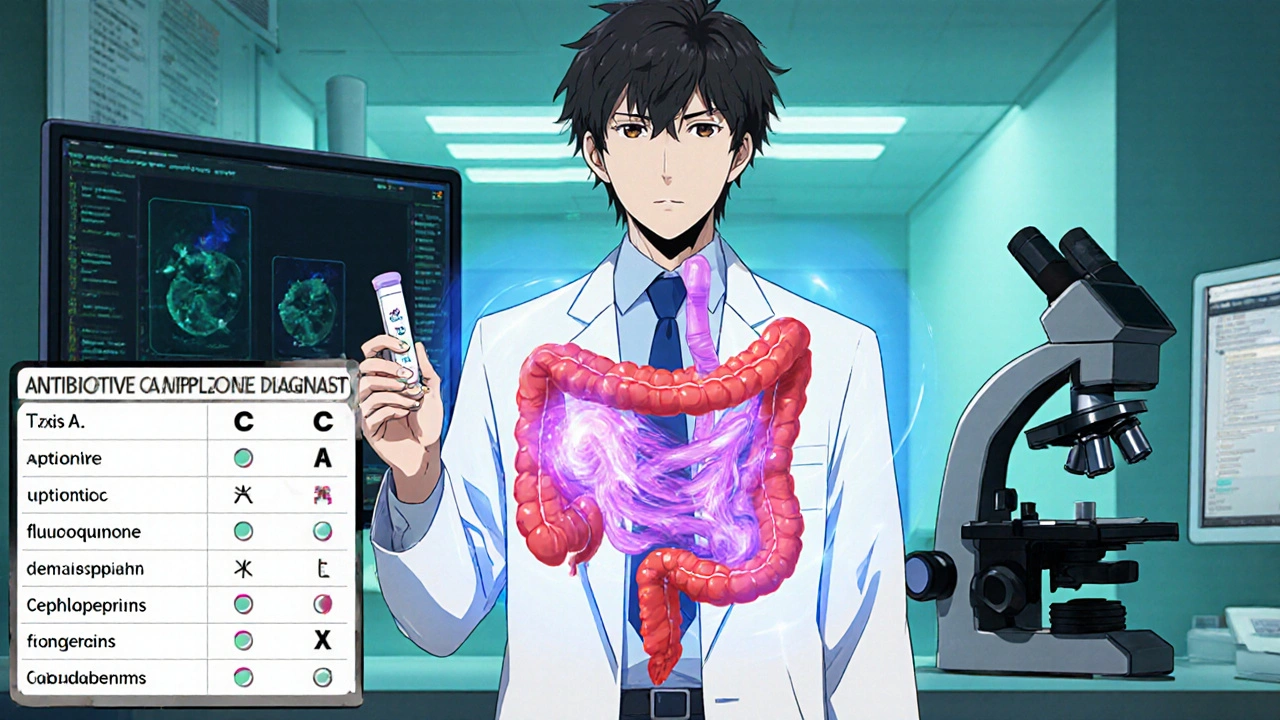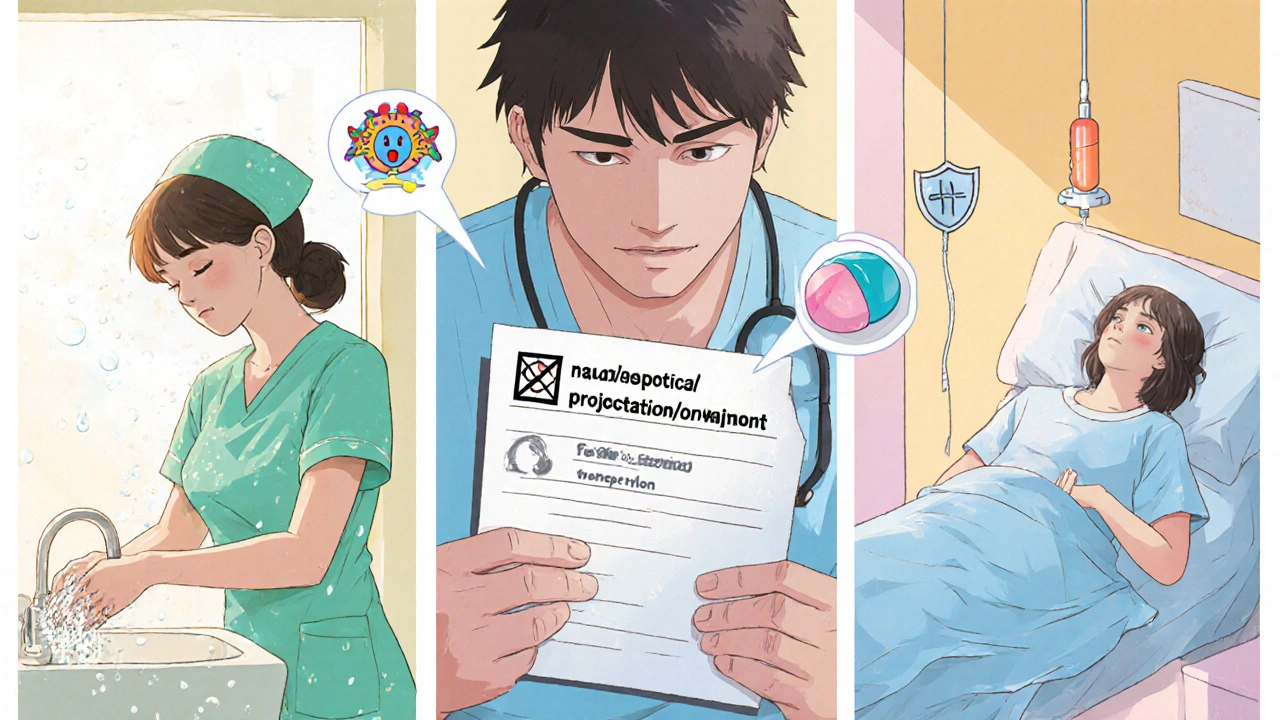CDI Risk Assessment Tool
Assess Your C. difficile Infection Risk
This tool helps estimate your risk of developing C. difficile infection based on antibiotic exposure and other factors. Results are for informational purposes only and should not replace medical advice.
Risk Assessment Results
Every time you finish a course of antibiotics, your gut gets a jolt. Most people chalk the loose stools up to a minor nuisance, but for some it can turn into a serious, even life‑threatening condition. This guide walks you through what antibiotic‑associated diarrhea is, why C. difficile infection is the worst‑case scenario, and exactly how to prevent and treat it.
What Is Antibiotic‑Associated Diarrhea?
Antibiotic-associated diarrhea (AAD) is a disruption of the normal gut microbiota caused by exposure to antimicrobial agents. The loss of beneficial bacteria allows opportunistic organisms to overgrow, leading to watery stools, cramping, and occasional fever.
Most cases are mild and resolve once the antibiotic course ends, but about 5‑10% of patients develop persistent symptoms that need medical attention.
Why Clostridioides difficile Is a Special Threat
Clostridioides difficile infection (CDI) is a severe form of AAD caused by a spore‑forming, Gram‑positive anaerobic bacillus. The bacterium produces toxin A and toxin B, which damage the colon lining and trigger inflammation, severe watery diarrhea, and sometimes toxic megacolon.
CDC data show that CDI accounts for 15‑25% of all AAD cases and leads to roughly 30,000 deaths within 30 days of diagnosis in the United States alone.
Antibiotics That Carry the Highest Risk
- Fluoroquinolones (e.g., ciprofloxacin, levofloxacin)
- Third‑ and fourth‑generation cephalosporins (e.g., ceftriaxone, cefepime)
- Clindamycin
- Carbapenems (e.g., meropenem, imipenem)
These drugs wipe out a broad spectrum of gut flora, creating a vacuum for C. difficile spores to germinate.
How CDI Is Diagnosed
Accurate diagnosis hinges on three criteria: an unformed stool sample, no laxative use in the prior 48 hours, and a reliable laboratory test. Most labs follow a two‑step algorithm-first a glutamate dehydrogenase (GDH) screen, then a toxin enzyme immunoassay (EIA) or nucleic acid amplification test (NAAT) for confirmation.
Because no single test guarantees 100% sensitivity and specificity, clinicians often combine results with clinical judgment (white‑blood‑cell count > 15,000 µL or serum creatinine > 1.5 mg/dL signals severe disease).

Treatment Options: What Works Best?
Therapy is stratified by severity. Below is a quick comparison of the most common regimens.
| Drug | Dose & Duration | Key Advantages | Typical Cost (US$) |
|---|---|---|---|
| Oral Vancomycin | 125 mg PO q6h × 10 days | Proven efficacy, widely available | 1,650 |
| Fidaxomicin | 200 mg PO BID × 10 days | Lower recurrence (≈13 % vs 22 % with vancomycin) | 3,350 |
| Metronidazole | 500 mg PO TID × 10 days | Cheap, oral formulation | 40 |
Guidelines now place vancomycin and fidaxomicin as first‑line choices; metronidazole is reserved for low‑risk, non‑severe cases because resistance has risen sharply.
Managing Severe and Fulminant CDI
Severe disease (WBC > 15,000 µL or creatinine > 1.5 mg/dL) still calls for oral vancomycin or fidaxomicin. Fulminant cases-characterized by hypotension, ileus, or megacolon-require a combination of high‑dose oral vancomycin (500 mg QID) plus intravenous metronidazole (500 mg q8h). If ileus prevents oral drug delivery, clinicians add rectal vancomycin enemas.
Importantly, anti‑diarrheal agents (e.g., loperamide) are discouraged because they trap toxins in the colon and can worsen outcomes.
Recurrent CDI: Beyond the First Course
Recurrence rates climb with each episode: roughly 20‑30 % after the first episode, > 40 % after the second, and > 60 % after multiple failures. Strategies evolve with the number of recurrences.
- First recurrence: repeat the initial effective agent or switch to fidaxomicin.
- Second or subsequent recurrence: extended vancomycin taper (10‑14 days high dose, then gradually decreasing frequency over 4‑8 weeks) or fidaxomicin followed by a short course of rifaximin.
- Multiple recurrences: fecal microbiota transplantation (FMT) - success rates 85‑90 % - or monoclonal antibody bezlotoxumab added to the antibiotic regimen (10 % absolute reduction in recurrence).
FDA‑approved microbiome products such as Rebyota (live‑jslm) and Vowst (live‑brpk) provide standardized FMT alternatives, easing access in hospitals without a dedicated stool bank.

Prevention: The Most Powerful Tools
Stopping CDI before it starts is far easier than treating it later.
- Antibiotic stewardship: prescribe the narrowest spectrum agent for the shortest effective duration. Studies show hospitals with robust stewardship cut CDI rates by ~26 %.
- Infection‑control measures: use EPA‑registered sporicidal disinfectants (List K), isolate symptomatic patients, and perform terminal cleaning of rooms.
- Hand hygiene: wash hands with soap and water for at least 20 seconds; alcohol‑based rubs do not kill C. difficile spores.
- Probiotics? Evidence is mixed. Certain strains (Saccharomyces boulardii, Lactobacillus rhamnosus GG) reduced CDI risk by up to 60 % in high‑risk subgroups, yet major guidelines still do not recommend routine use.
- Environmental vigilance: educate patients and caregivers about cleaning high‑touch surfaces (bed rails, bathroom fixtures) with sporicidal wipes, especially after discharge.
Practical Tips for Patients and Caregivers
- Keep a symptom diary: note stool frequency, consistency, and any fever.
- Stay hydrated - oral rehydration solutions are better than sugary sodas.
- Avoid antidiarrheal meds and laxatives until cleared by a clinician.
- Follow the full antibiotic course even if you feel better; stopping early encourages resistance.
- Ask your doctor about a probiotic trial only if you’re immunocompetent and not severely ill.
- If you’ve had CDI before, discuss bezlotoxumab or FMT before the next infection.
Frequently Asked Questions
Can I get C. difficile from food?
C. difficile spores are not typically transmitted through food. The main route is fecal‑oral spread via contaminated hands or surfaces, especially in healthcare settings.
How long does it take to recover from a first‑time CDI?
Most patients notice improvement within 3 days of starting oral vancomycin or fidaxomicin, but full resolution of diarrhea may take up to 2 weeks. Follow‑up stool testing is usually done after treatment ends.
Is it safe to take probiotics while on antibiotics?
Probiotics are generally safe for healthy adults, but they should be started after the antibiotic course finishes. Immunocompromised patients should avoid live‑culture supplements unless a physician approves.
What triggers a recurrence after successful treatment?
Re‑exposure to high‑risk antibiotics, persistent dysbiosis, or an untreated colonized state can all lead to relapse. A tapered vancomycin regimen or FMT reduces the odds of a second episode.
Do over‑the‑counter anti‑diarrheal drugs help?
No. They can trap toxins in the gut and worsen colitis. The best approach is targeted antibiotic therapy plus supportive care.



Carolyn Cameron
October 26, 2025 AT 18:54Esteemed readers, the comprehensive nature of this guide merits commendation for its meticulous delineation of antibiotic‑associated diarrhoea and the formidable threat posed by Clostridioides difficile. It begins with a clear definition of AAD, elucidating the perturbation of the gut microbiota consequent upon broad‑spectrum antimicrobial exposure. The epidemiological data presented underscore the gravity of CDI, citing mortality figures that are both alarming and instructive. By enumerating the specific classes of antibiotics that confer the highest risk, the author equips clinicians with actionable intelligence for stewardship initiatives. The diagnostic algorithm, with its emphasis on stool testing and clinical correlation, reflects current best practice standards. Therapeutic recommendations are judiciously stratified by disease severity, offering evidence‑based first‑line options such as oral vancomycin and fidaxomicin. The discussion of metronidazole’s relegated role illustrates the evolving resistance landscape. In addressing fulminant disease, the guide prudently advocates for combination therapy and rectal administration where indicated. The nuanced approach to recurrence, including taper regimens and fecal microbiota transplantation, is particularly valuable for refractory cases. Moreover, the inclusion of emerging microbiome therapeutics broadens the therapeutic armamentarium. Preventive strategies are articulated with a commendable emphasis on antimicrobial stewardship, environmental hygiene, and handwashing with soap, thereby aligning with infection‑control imperatives. The balanced appraisal of probiotics acknowledges both potential benefit and guideline reservations. Practical tips for patients and caregivers enhance the guide’s utility beyond the professional sphere. The FAQ section anticipates common concerns, delivering concise, evidence‑based answers. Overall, the guide exemplifies scholarly rigor while remaining accessible to a diverse readership, and it should serve as a reference cornerstone in both inpatient and outpatient settings.
Holly Kress
November 12, 2025 AT 02:06I appreciate the thoroughness of this article; it really helps demystify a complex topic. The step‑by‑step prevention checklist is especially useful for anyone prescribing antibiotics. It’s good to see the emphasis on hand‑washing with soap rather than alcohol gels. The guidance on when to consider probiotics is balanced and avoids over‑promising. Overall, a solid resource for both clinicians and patients.
Chris L
November 28, 2025 AT 09:18Great job laying out the risk factors so clearly. Knowing which antibiotics are high‑risk helps me choose narrower agents when possible. The treatment table is a handy quick‑reference for busy wards. I also like the tip about avoiding antidiarrheals; that’s a common mistake.